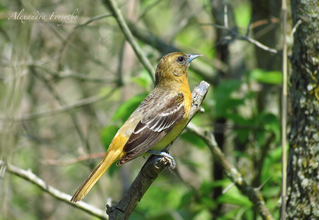Even if you are self-quarantined due to COVID-19, there’s always something new and interesting to see in your own yard. Take a look at this lovely gentleman, for example. It doesn’t look like the stereotypical American Goldfinch, does it? We’re heading toward mating season for the goldfinch, so by now most of the males you see at your feeders have almost finished molting into their trademark golden and black plumage. However, some males won’t finish changing into their breeding plumage until June. This failure to launch doesn’t necessarily condemn this bird to a life of bachelorhood living in his parents’ basement. There’s still hope for him. Since goldfinches feed on thistles and similar seeds, they breed later than most of our songbirds, waiting for those seeds to be in abundance to feed to their young. So never fear! This late bloomer will probably do some “adulting” and find a lovely mate. Or at least his parents hope so! Ha!
|
Let's play the children's game of "Duck, duck, goose!"
If I ask people to tell me the color of a male Mallard's head, most would say it is green. That's true in bright sunlight, but if you're lucky to catch one on a bright but overcast day, you'll see a beautiful blue sheen mixed with the blue. The females are no less lovely, sporting an intricate brown and white pattern with just a hint of rust. If I ask people to describe the nest of a Canada Goose, I would get a range of answers, and all of them would likely be correct. Take a look at these two nests. One is a master woodworker that painstakingly wove twigs together to form a basket that Longaberger would envy. The other is a master at remodeling, transforming a tree stump into a perfect nursery. There are few birds more beautiful in song and plumage than the Baltimore Oriole. The song is liquid and rich resembling the sound of a flute, and both the male and female have beautiful orange and yellow colors accented with black and punctuated with white. I've put out the welcome mat for my resident Baltimore Orioles. They should be returning any day now to build their nest that resembles a stocking hanging from the outer tip of a branch. If you want to attract orioles, don't bother with that orange syrup they sell at the stores. Instead, put out orange halves or plain grape jelly. Better yet, plant a mulberry tree so you and the orioles can share the fruit!
|
AuthorAlex Forsythe Archives
May 2020
Categories |









 RSS Feed
RSS Feed
